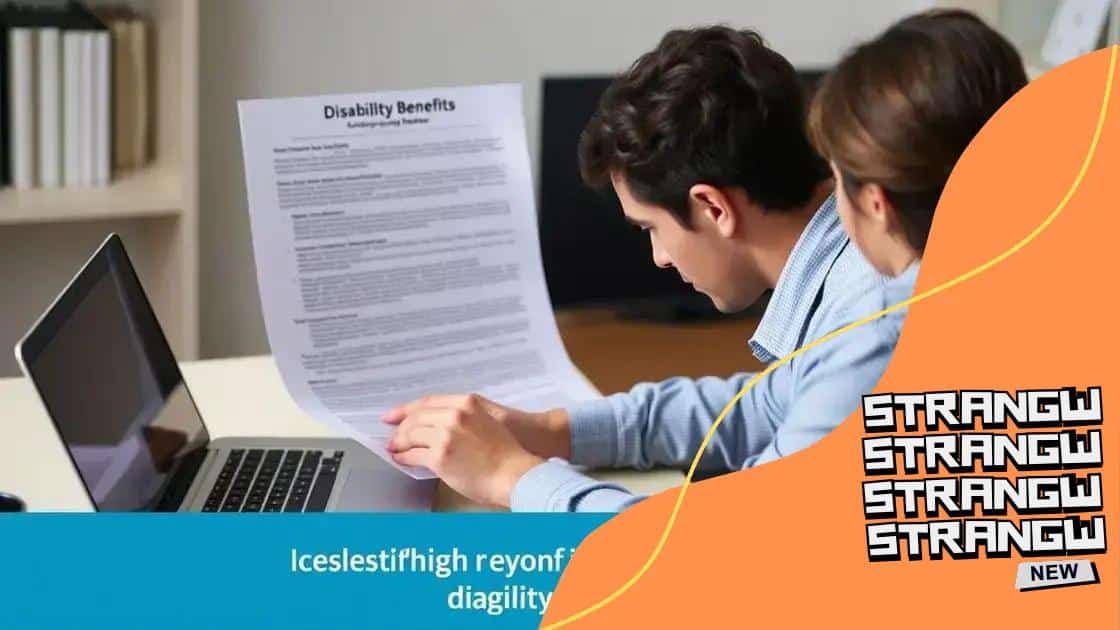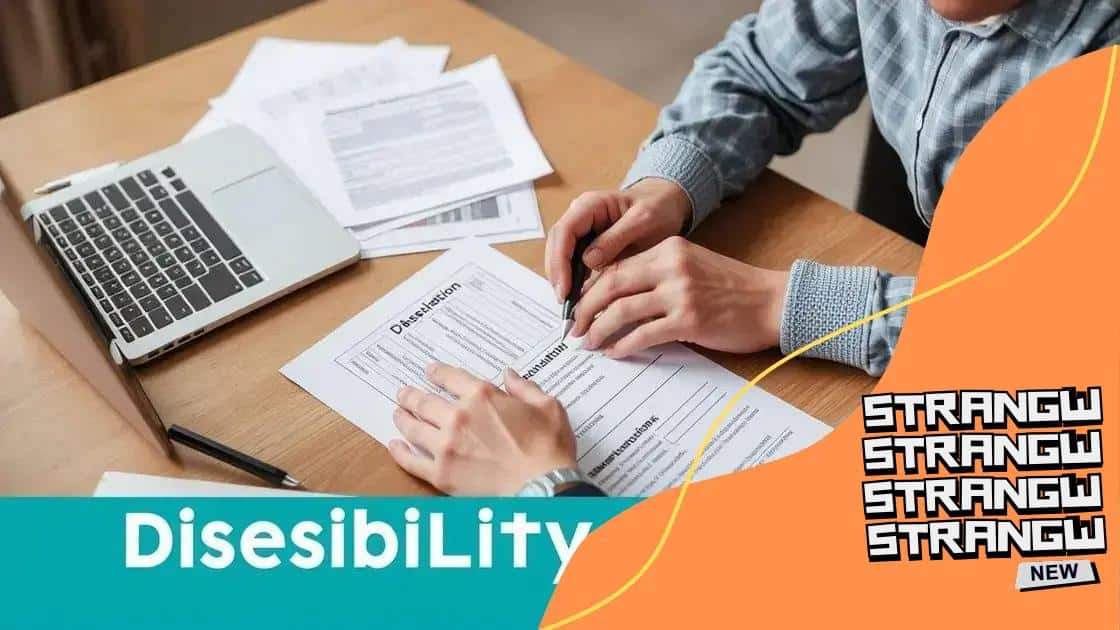Disability benefits eligibility updates: what you need to know

Disability benefits eligibility updates include changes in laws, application processes, and the importance of understanding criteria to successfully secure financial assistance for individuals with disabilities.
Disability benefits eligibility updates are vital for anyone relying on these resources. With changes occurring regularly, staying informed can make a big difference. Have you checked the latest updates that might affect you?
Understanding disability benefits eligibility criteria
Understanding disability benefits eligibility criteria is crucial for those who seek financial support. Knowing what qualifies you can make a significant difference in your situation. This section will break down the essential factors that determine whether you are eligible for benefits.
Who Is Eligible?
Eligibility for disability benefits typically includes several criteria. To qualify, individuals usually need to prove that their condition significantly limits their ability to work. Here are some common qualifications:
- Your disability must be recognized by the Social Security Administration.
- You must have worked for a certain number of years in jobs covered by Social Security.
- Medical documentation must support your disability claims.
- Your condition should impede your ability to perform basic work activities.
Furthermore, applicants are assessed on their work history and how income affects eligibility. For many, the disability benefits application process can feel daunting, due to the complexities involved.
Types of Disabilities
Understanding the types of disabilities recognized can aid in determining eligibility. There are various categories, including:
- Physical disabilities: Conditions such as paralysis or severe arthritis.
- Mental health disorders: This includes severe depression, anxiety disorders, and schizophrenia.
- Chronic illnesses: Such as cancer, multiple sclerosis, and AIDS.
- Neurological disorders: Including epilepsy and Parkinson’s disease.
Keep in mind that each case is unique, and the assessment process can vary depending on personal circumstances. Gathering thorough medical evidence is essential. This includes doctors’ reports and treatment history, as these documents significantly strengthen your case.
It’s also worth noting that the eligibility criteria may differ between state and federal programs. Therefore, it’s advisable for applicants to research the specific requirements pertinent to their state of residence, as this knowledge can greatly aid in the application process.
Recent changes in disability benefits laws
Recent changes in disability benefits laws can have a significant impact on individuals seeking assistance. It’s essential to stay updated on these modifications to understand how they may affect your eligibility and benefits.
Key Changes in Legislation
Several new laws have been enacted recently to improve access to disability benefits. These changes aim to streamline the application process and make it more efficient. Among the key updates are:
- Reduction of waiting times for benefits approval.
- Increased funding for disability assessments.
- Expansion of the definition of qualifying disabilities.
- Improvements in online application systems.
These changes reflect a broader commitment to support those living with disabilities. However, understanding the nuances of these new laws can be tricky.
Impact on Applicants
As laws evolve, so too do the procedures involved in applying for benefits. Individuals are encouraged to familiarize themselves with these recent changes to increase their chances of successful applications. Furthermore, adequate documentation and understanding of your rights under the new laws can enhance your position when applying.
Regularly checking government websites and reliable sources will aid in staying informed. You can also connect with disability advocacy groups, which often provide resources and updates about relevant legislative changes.
Remember, it’s not just about understanding the laws themselves. It’s also crucial to know how to navigate the application procedures they influence. Keeping well-informed can empower you and others in similar situations.
How to apply for disability benefits

Applying for disability benefits can be a complicated process, but understanding the steps can help make it easier. Knowing what to expect is key to ensuring your application is successful.
Gather Necessary Documentation
Before starting your application, it is important to gather all necessary documents. This includes:
- Medical records: Obtain your medical history and relevant treatment documentation.
- Work history: Document your job history and details about the types of work you’ve done.
- Personal identification: Have your Social Security number and other ID ready.
- Financial information: Prepare details about your income and assets.
Having these documents at hand will simplify the application process and improve your chances of approval.
Filling Out the Application
Once you have your documentation, you can fill out the application. This can be done online, or in person at your local Social Security office. It is vital to be clear and accurate. Double-check your application before submitting.
When describing your disability, use specific language about how it affects your ability to perform daily tasks and work. This detail can significantly impact your application.
In the case of an online application, carefully read each section and answer every question fully. Incomplete or incorrect answers can lead to delays.
Follow Up on Your Application
After submission, it’s essential to follow up on your application. Keep track of any communication from the Social Security Administration. If you don’t receive updates, don’t hesitate to call and ask about the status of your application.
Be prepared for possible additional requests for information or appeals if your application is denied. This step is common, so don’t be discouraged.
Common pitfalls in the application process
Identifying common pitfalls in the application process for disability benefits can greatly enhance your chances of approval. Understanding these challenges allows applicants to prepare better and avoid mistakes that can lead to delays or denials.
Incomplete Applications
One of the most frequent mistakes is submitting an incomplete application. It’s crucial to ensure that all sections are filled out thoroughly. Missing details can result in your application being delayed or outright denied.
Additionally, be certain to include all necessary documentation. This includes:
- Medical evidence supporting your disability claim.
- Work history verification, showing your employment background.
- Personal identification and Social Security number.
Failing to Provide Medical Documentation
Another common pitfall involves inadequate medical documentation. This documentation must clearly outline your diagnosis and how it affects your daily life and ability to work. Without it, the proving of your disability can be challenging.
Comprehensive medical records can strengthen your case. Always request updated reports from healthcare providers and ensure they detail your condition and how it limits your capacity for work.
Ignoring Deadlines
Missing deadlines is a critical error in the application process. Each step in applying for disability benefits comes with specific timeframes. Applicants must stay aware of these to avoid losing their chance to receive necessary support.
Set reminders for every stage of the process so that you never miss a crucial deadline. This habit can prevent unnecessary stress and complications.
Not Following Up
Finally, many applicants fail to follow up on their applications. After submitting your application, checking the status actively is important. If you don’t hear back within a reasonable time, consider reaching out to the Social Security Administration for updates.
Being proactive about your application can help you address any potential issues before they become major roadblocks.
Resources for assistance with disability benefits
Finding the right resources for assistance with disability benefits can be overwhelming. Fortunately, many organizations and tools are available to help guide you through the process of applying for benefits and navigating the complexities that come with it.
Government Resources
The first stop for most applicants should be the official Social Security Administration (SSA) website. Here, you can find a variety of resources, including:
- Online applications: This is where you can fill out and submit your disability benefits application.
- Frequently asked questions: The SSA website provides answers to common questions that can clarify the application process.
- Contact information: If you need assistance, there are various ways to contact the SSA for help.
Additionally, each state often has specific local offices where you can receive direct assistance and learn about state-specific resources available to you.
Non-Profit Organizations
Many non-profit organizations offer free support and guidance for individuals applying for disability benefits. They can provide valuable resources such as:
- Workshops: Educational sessions focusing on understanding the application process.
- Case management: Assistance with gathering documents and filling out forms.
- Legal advice: Access to attorneys who specialize in disability claims.
These organizations often have the expertise to help ensure that your application is complete and meets all requirements.
Support Groups
Joining support groups can also be beneficial. Meeting others who are navigating similar challenges allows for sharing experiences and tips. Online forums and local support groups can provide a space to discuss difficulties you may face during the application process. Connecting with others can offer emotional support and practical advice that proves invaluable.
Exploring these resources can not only simplify the application process but also offer the support needed throughout your journey to secure disability benefits.
FAQ – Common Questions About Disability Benefits Applications
What are the eligibility criteria for disability benefits?
To qualify for disability benefits, individuals must show that their disability severely limits their ability to work and meet specific income and work history requirements.
What recent changes have been made to disability benefits laws?
Recent changes include streamlined application processes, updated definitions of qualifying disabilities, and increased funding for assessments.
What are some common pitfalls when applying for disability benefits?
Common pitfalls include submitting incomplete applications, failing to provide adequate medical documentation, and not following up on the application status.
Where can I find resources for assistance with my disability benefits application?
Resources can be found on the Social Security Administration’s website, through non-profit organizations, and via support groups that provide guidance and assistance.





